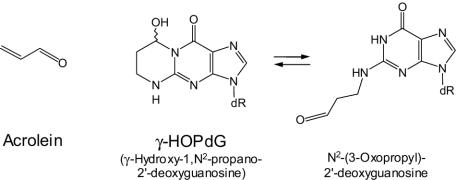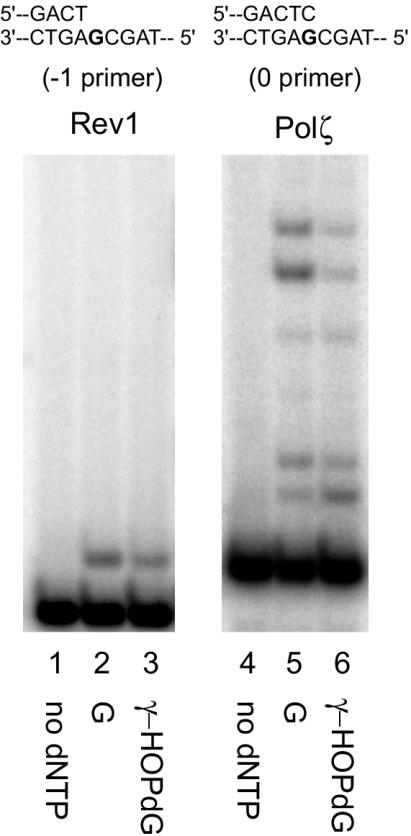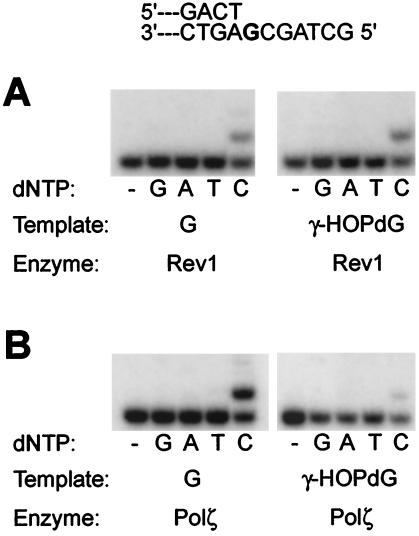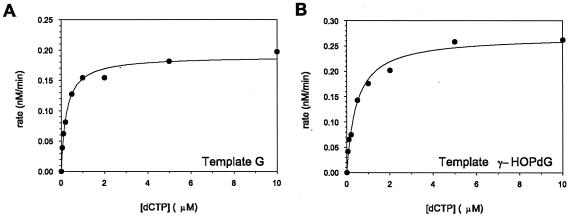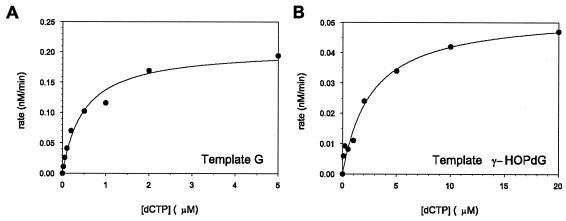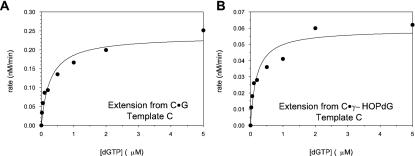Abstract
Rev1, a member of the Y family of DNA polymerases, functions in lesion bypass together with DNA polymerase ζ (Polζ). Rev1 is a highly specialized enzyme in that it incorporates only a C opposite template G. While Rev1 plays an indispensable structural role in Polζ-dependent lesion bypass, the role of its DNA synthetic activity in lesion bypass has remained unclear. Since interactions of DNA polymerases with the DNA minor groove contribute to the nearly equivalent efficiencies and fidelities of nucleotide incorporation opposite each of the four template bases, here we examine the possibility that unlike other DNA polymerases, Rev1 does not come into close contact with the minor groove of the incipient base pair, and that enables it to incorporate a C opposite the N2-adducted guanines in DNA. To test this idea, we examined whether Rev1 could incorporate a C opposite the γ-hydroxy-1,N2-propano-2′deoxyguanosine DNA minor-groove adduct, which is formed from the reaction of acrolein with the N2 of guanine. Acrolein, an α,β-unsaturated aldehyde, is generated in vivo as the end product of lipid peroxidation and from other oxidation reactions. We show here that Rev1 efficiently incorporates a C opposite this adduct from which Polζ subsequently extends, thereby completing the lesion bypass reaction. Based upon these observations, we suggest that an important role of the Rev1 DNA synthetic activity in lesion bypass is to incorporate a C opposite the various N2-guanine DNA minor-groove adducts that form in DNA.
DNA polymerases of the Y family promote replication through DNA lesions, and eukaryotic cells possess at least two Y family polymerases, Polη and Rev1 (34). Polη from both Saccharomyces cerevisiae and humans promotes error-free replication through UV-induced cyclobutane pyrimidine dimers, and steady-state and pre-steady-state kinetic analyses have indicated that Polη incorporates two As opposite the two Ts of a cis-syn TT dimer with the same efficiency and fidelity as opposite the undamaged Ts (13, 16, 36, 38). Because of its role in error-free replication through cyclobutane pyrimidine dimers, inactivation of Polη in humans causes UV hypermutability and results in the cancer-prone syndrome, the variant form of xeroderma pigmentosum (12, 25). Polη can also replicate through an 8-oxoguanine and, to a somewhat lesser extent, through an O6-methylguanine (7, 10). Polη, however, is inhibited by DNA lesions such as the N2-guanine adducts of 1,3-butadiene or benzo[a]pyrene diol epoxide (27, 35).
Rev1 differs from other Y family DNA polymerases in its inability to incorporate nucleotides opposite all four template bases. Instead, Rev1 is a highly specialized enzyme, able to incorporate a C opposite template G, and yeast Rev1 misincorporates nucleotides opposite template G with a frequency of ∼10−3 to 10−4 (8, 31). To determine if the polymerase activity of Rev1 could be utilized for promoting replication through DNA lesions, we tested its ability to incorporate a C opposite an 8-oxoguanine and an O6-methylgunaine, DNA lesions that result from the action of oxygen free radicals and alkylating agents, respectively, on the bases in DNA. Steady-state kinetic analyses, however, have indicated that Rev1 is 400-fold and 40-fold less efficient at the incorporation of a C opposite the 8-oxoguanine and O6-methylguanine lesions, respectively, than the incorporation of a C opposite an undamaged G (8).
Rev1 functions in translesion DNA synthesis (TLS) together with Polζ, which is comprised of the Rev3 and Rev7 subunits (32). Mutagenesis induced by DNA damaging agents, such as by UV light (23) or that resulting from TLS through abasic sites (14), is dependent upon the REV1, REV3, and REV7 genes, as deletion of any of these genes confers a large reduction in mutagenesis. The ability of Rev1 to incorporate a C opposite template G, however, makes no significant contribution to the bypass of either of these lesions: C incorporation occurs very rarely opposite cis-syn TT, TC, or CC dimers or (6-4) photoproducts, and mutational inactivation of the Rev1 polymerase activity has no effect on UV mutagenesis. Although a role for C incorporation opposite an abasic (AP) site has been previously suggested (31), the Rev1 DNA synthetic activity is unlikely to make a major contribution to AP bypass, because in yeast genomic DNA, A is the nucleotide inserted most often opposite this lesion (9). We have previously suggested that we expect the replicative polymerase, Polδ, which would be the first polymerase to encounter the lesion and which inserts an A opposite the AP site, from which Polζ efficiently extends, to make a major contribution to AP bypass. And, in accord with this proposal, mutational inactivation of Rev1 DNA synthetic activity has no effect on mutagenesis resulting from AP bypass (9). Although the Rev1 DNA synthetic activity appears to make no significant contribution to the mutagenic bypass of UV lesions or AP sites, the absolute requirement of the Rev1 protein for Polζ-dependent lesion bypass has led to the proposal that a major role of Rev1 is to facilitate the assembly of Polζ with the replication machinery stalled at the lesion site (9). However, in spite of the lack of any clear evidence for the involvement of the Rev1 DNA synthetic activity in TLS, we consider it highly probable that this enzymatic activity, in fact, plays an important role in the bypass of certain biologically relevant DNA lesions, for otherwise, this activity would have not remained so well conserved during evolution.
An important feature shared by DNA polymerases is that they incorporate nucleotides opposite the four template bases with nearly similar efficiencies and fidelities, and interactions with the DNA minor groove contribute to this property, as DNA polymerases sense the correct base pair geometry, in part via their hydrogen bonding with the N3 (purine) and O2 (pyrimidine) atoms in the minor groove. The fact that Rev1 incorporates the correct nucleotide only opposite template G suggested, however, that unlike other polymerases, the Rev1 active site may not come into close contact with the minor groove of DNA, particularly at the site of the incipient base pair, and that might enable Rev1 with the ability to incorporate a C opposite minor-groove adducted Gs. Since the minor-groove N2 group of guanine is highly reactive, able to conjugate with a variety of endogenously formed adducts, we considered the possibility that an important biological role of Rev1 DNA polymerase activity is in promoting TLS through such lesions.
Acrolein, an α,β-unsaturated aldehyde, is generated in vivo as the end product of lipid peroxidation and during metabolic oxidation of polyamines, and it is also a ubiquitous environmental pollutant formed from incomplete combustion of organic materials (3, 4, 24, 33). The reaction of acrolein with the N2 of dG followed by ring closure at N1 leads to the formation of the cyclic adduct γ-hydroxy-1,N2-propano-2′deoxyguanosine (γ-HOPdG) (Fig. 1), and this adduct has been detected in mammalian tissues at relatively high levels (2, 4, 28, 29). In the nucleoside and in single-stranded DNA, γ-HOPdG exists primarily in its ring closed form (22, 30). As indicated from nuclear magnetic resonance studies, in duplex DNA, however, when γ-HOPdG is paired with a C, the exocyclic ring opens to form N2-(3-oxopropyl)-2′-deoxyguanosine (Fig. 1). For this isomer, the modified G participates in a normal Watson-Crick base pairing with C, with the N2-propyl chain in the minor groove pointing toward the solvent (5, 19, 21).
FIG. 1.
Structures of acrolein and acrolein-derived DNA adducts.
DNA synthesis by various DNA polymerases, including Escherichia coli Pol I and human Polδ and Polɛ, is inhibited by γ-HOPdG (18). Although yeast Polη can replicate through the γ-HOPdG adduct, DNA synthesis is strongly inhibited right before the lesion, and steady-state kinetic analyses have indicated that the efficiency of C incorporation opposite γ-HOPdG is reduced by ∼200-fold relative to C incorporation opposite an undamaged G (26). Here we show that Rev1 efficiently incorporates a C opposite γ-HOPdG and that such a primer terminus is efficiently extended by Polζ. Based on these observations, we propose that an important function of Rev1's enzymatic activity is to promote efficient and error-free TLS through the variety of minor-groove adducts that form at the N2 position of guanine in DNA.
MATERIALS AND METHODS
Purification of yeast Polζ and Rev1.
Yeast Polζ was expressed and purified as a glutathione S-transferase (GST) fusion protein as previously described (15). Briefly, Polζ was expressed in yeast strain Sc334 carrying plasmids pGST-Rev3 and pRev7. GST-Polζ was eluted from the glutathione-Sepharose 4B matrix (Amersham Pharmacia), dialyzed, and loaded on a mini-Q PC 3.2/3 column (Amersham Pharmacia). The Rev1 protein was expressed and purified as a GST fusion protein as previously described (9). Briefly, Rev1 was expressed in yeast strain LY2 carrying plasmid pGST-Rev1. The GST-Rev1 protein was eluted from the glutathione-Sepharose 4B matrix, dialyzed, and loaded on a mini-S column (Amersham Pharmacia).
DNA and nucleotide substrates.
Nonadducted oligodeoxynucleotides were obtained from Midland Certified Reagent Co. (Midland, Tex.). Oligodeoxynucleotides containing a site-specific γ-HOPdG were synthesized as previously described (30) and have been extensively characterized (19-21). The −1 primer was a 21-mer oligodeoxynucleotide with the sequence 5′-AGCCC AAGCT TGGCG CGGAC T, and the 0 primer was a 21-mer oligodeoxynucleotide with the sequence 5′-GCCCA AGCTT GGCGC GGACT C. The following oligodeoxynucleotides were used as a template: 5′-GCT AGCGA GTCCG CGCCA AGCTT GGGCT GCAGC AGGTC, where the underlined G is either an undamaged G or a γ-HOPdG. The primer strands were 32P-5′-end labeled using polynucleotide kinase and [γ-32P]ATP. Labeled primer strands (100 nM) were annealed to template strands (100 nM) in 50 mM Tris HCl (pH 7.5) and 100 mM NaCl by heating to 95°C for 2 min and slowly cooling to room temperature over several hours. Solutions of dGTP, dATP, dTTP, and dCTP (100 mM each) were purchased from Roche Diagnostic Corporation and stored in 5-μl aliquots at −80°C.
DNA polymerase assays and steady-state kinetics.
Single deoxynucleotide incorporation experiments were carried out using a 1 nM concentration of either Polζ or the Rev1 protein, a 20 μM concentration of one of the deoxynucleoside triphosphates (dNTPs), and 10 nM DNA substrate in 25 mM Tris HCl (pH 7.5), 10 mM NaCl, 5 mM MgCl2, 5 mM dithiothreitol, and 0.1 mg of bovine serum albumin/ml at 22°C. Reactions were quenched after 30 min by the addition of 10 volumes of formamide loading buffer. Quenched samples were boiled for 2 min and run on a 15% polyacrylamide sequencing gel containing 8 M urea. DNA synthesis reactions were carried out under the same conditions, except that a 20 μM concentration of each of the four dNTPs and 5 nM DNA substrate were used. The steady-state kinetics of single-deoxynucleotide incorporation were measured under the same conditions as the single-deoxynucleotide incorporation experiments, except that the concentrations of dNTPs were varied from 0 to 500 μM and the reactions were quenched after 15 or 30 min. The intensity of the gel bands corresponding to the substrate and the product were quantitated using a PhosphorImager (Molecular Dynamics), and the observed rate of nucleotide incorporation was plotted as a function of dNTP concentration. The kcat and Km steady-state parameters were obtained from the best fit of the data to the Michaelis-Menten equation as follows: vobs = kcat[E] [dNTP]/(Km + [dNTP]).
RESULTS
Replication past γ-HOPdG by the sequential action of Rev1 and Polζ.
To test the role of Rev1 in the bypass of N2-deoxyguanosine DNA minor-groove adducts, we examined the ability of this enzyme to incorporate nucleotides opposite the acrolein-derived γ-HOPdG adduct. Rev1 (1 nM) was incubated with 5 nM DNA substrate containing a template G or a template γ-HOPdG residue in the presence of all four dNTPs (20 μM each). In both cases, only a single nucleotide was incorporated, and no further extension of the primer was observed (Fig. 2, lanes 2 and 3). Because Rev1 only incorporates a C opposite template G, extension from the C inserted opposite the γ-HOPdG adduct would not be carried out by Rev1 in most sequence contexts. Because of its proficient ability to extend primer termini opposite from DNA lesions in the template strand (9, 11, 15, 17), next we examined whether Polζ could complete the bypass reaction by extending from the C incorporated opposite γ-HOPdG by Rev1. To examine this, Polζ (1 nM) was incubated with 5 nM DNA substrate in which C was placed opposite either the nondamaged G or the γ-HOPdG template residue, and the results showed that Polζ could promote the extension of the primer terminus opposite from γ-HOPdG (Fig. 2, lanes 5 and 6). And as expected, Rev1 and Polζ together effected replication through the γ-HOPdG lesion, whereas with Polζ alone a strong stall site was seen just before the lesion, which suggested that γ-HOPdG is a block to nucleotide incorporation by Polζ (data not shown). These observations indicated that replication through the γ-HOPdG adduct could occur by the sequential action of Rev1 and Polζ, where Rev1 inserts a C opposite this adduct and Polζ carries out the subsequent extension reaction.
FIG. 2.
Replication through the γ-HOPdG adduct catalyzed by Rev1 and Polζ. DNA substrates (5 nM) with either the −1 primer, in which the primer end is located 1 nucleotide before the undamaged G or the γ-HOPdG adduct (lanes 1 to 3), or the 0 primer, in which the primer end is located opposite the undamaged G or the γ-HOPdG adduct (lanes 4 to 6) annealed to templates containing the undamaged G (lanes 1, 2, 4, and 5) or the γ-HOPdG adduct (lanes 3 and 6), were incubated with all four dNTPs (20 μM each) and a 1 nM concentration of either the Rev1 protein (lanes 1 to 3) or Polζ (lanes 4 to 6) for 30 min at 22°C.
Nucleotide incorporated opposite γ-HOPdG by Rev1.
To identify the nucleotide incorporated opposite the γ-HOPdG adduct by Rev1, we carried out single-nucleotide incorporation experiments in which 1 nM Rev1 was incubated with 10 nM DNA substrate containing either a G or a γ-HOPdG residue as the first available template base in the presence of a 20 μM concentration of one of the four dNTP substrates. As shown in Fig. 3A, Rev1 only inserted a C opposite the γ-HOPdG adduct, as it did opposite the nonadducted G. In experiments similar to those done with Rev1, we also examined whether Polζ could incorporate a nucleotide opposite the γ-HOPdG adduct. Although Polζ could incorporate a C opposite γ-HOPdG, it occurred at a significantly reduced level (Fig. 3B).
FIG. 3.
Nucleotide incorporation opposite the γ-HOPdG adduct by the Rev1 protein and Polζ. DNA substrates (10 nM) with either a template G or γ-HOPdG were incubated with either 1 nM Rev1 (A) or Polζ (B) and the indicated dNTP substrate (20 μM) for 30 min at 22°C.
Steady-state kinetics of nucleotide incorporation opposite γ-HOPdG.
To measure the efficiency (kcat/Km) of nucleotide incorporation opposite the γ-HOPdG adduct by Rev1 and Polζ, we performed steady-state kinetic analyses. For this, we examined the kinetics of incorporation of all four dNTPs opposite a nondamaged template G and opposite γ-HOPdG by Rev1. Figure 4 shows the observed rate of C incorporation opposite these two template residues, graphed as a function of dCTP concentration. From the best fit of these data to the Michaelis-Menten equation, we obtained the kcat and Km steady-state parameters for this reaction (Table 1). We also examined the steady-state kinetics of dGTP, dATP, and dTTP incorporation opposite the nondamaged G and γ-HOPdG templates, and the kcat and Km steady-state parameters for these reactions are presented in Table 1. Opposite the nondamaged G template, C was incorporated approximately 1,000-fold and 6,000-fold more efficiently than the incorporation of G and T, respectively, and no incorporation of A was detected. Opposite the γ-HOPdG adduct, C was incorporated approximately 700-fold more efficiently than G, and no incorporation of A or T opposite the γ-HOPdG adduct was detected. Importantly, the efficiency of C incorporation opposite the γ-HOPdG adduct was about the same as that opposite the nondamaged template G residue.
FIG. 4.
Steady-state kinetics of nucleotide incorporation opposite the γ-HOPdG adduct by the Rev1 protein. The steady-state rates of dCTP incorporation opposite either a template G (A) or a template γ-HOPdG (B) were graphed as a function of dCTP concentration. The kcat and Km parameters were obtained from the best fit to the Michaelis-Menten equation and are listed in Table 1.
TABLE 1.
Steady-state kinetic parameters of nucleotide incorporation by Rev1 opposite undamaged G and γ-HOPdG
| dNTP | kcat (min−1) | Km (μM) | kcat/Kma | fincb | Relative efficiencyc |
|---|---|---|---|---|---|
| Template G | |||||
| dGTP | 0.087 ± 0.006 | 110 ± 20 | 7.9 × 10−4 | 1.0 × 10−3 | |
| dATP | ND | ND | <1 × 10−4 | ||
| dTTP | 0.037 ± 0.011 | 290 ± 170 | 1.3 × 10−4 | 1.6 × 10−4 | |
| dCTP | 0.19 ± 0.005 | 0.24 ± 0.03 | 0.79 | ||
| Template γ-HOPdG | |||||
| dGTP | 0.046 ± 0.004 | 53 ± 17 | 8.7 × 10−4 | 1.5 × 10−3 | |
| dATP | ND | ND | <1 × 10−4 | ||
| dTTP | ND | ND | <1 × 10−4 | ||
| dCTP | 0.27 ± 0.01 | 0.46 ± 0.06 | 0.59 | 0.75 |
When no incorporation was detected (ND), kcat/Km was below the detection limit for the assay, which is 1×10−4 μM−1·min−1.
finc equals (kcat/Km)incorrect/(kcat/Km)correct.
Indicates the efficiency of C incorporation opposite γ-HOPdG relative to the efficiency of C incorporation opposite undamaged G.
We also determined the efficiency of C incorporation opposite the γ-HOPdG adduct by Polζ. Figure 5 shows the observed rate of nucleotide incorporation opposite the nondamaged G and γ-HOPdG adduct graphed as a function of dCTP concentration, and the kcat and Km values derived from these curves are given in Table 2. The efficiency of C incorporation opposite γ-HOPdG by Polζ was ∼20-fold lower than that opposite the nondamaged G residue.
FIG. 5.
Steady-state kinetics of nucleotide incorporation opposite the γ-HOPdG adduct by Polζ. The steady-state rates of dCTP incorporation opposite either a template G (A) or a template γ-HOPdG (B) were graphed as a function of dCTP concentration. The kcat and Km parameters were obtained from the best fit to the Michaelis-Menten equation and are listed in Table 2.
TABLE 2.
Steady-state kinetic parameters for C incorporation opposite undamaged G and γ-HOPdG by Polζ
| Template nucleotide | kcat (min−1) | Km (μM) | kcat/Km | Relative efficiencya |
|---|---|---|---|---|
| G | 0.21 ± 0.01 | 0.49 ± 0.09 | 0.43 | |
| γ-HOPdG | 0.053 ± 0.004 | 2.6 ± 0.6 | 0.020 | 0.05 |
Relative efficiency indicates the efficiency of C incorporation opposite γ-HOPdG relative to the efficiency of C incorporation opposite undamaged G.
Steady-state kinetics of extension of the primer terminus opposite from γ-HOPdG by Polζ.
Next, we examined the steady-state kinetics of extension by Polζ from a C incorporated opposite the γ-HOPdG adduct. Figure 6 shows the observed rate of G incorporation by Polζ opposite a template C residue following a C · G and a C · γ-HOPdG primer terminal base pair graphed as a function of dGTP concentration, and the kcat and Km parameters are listed in Table 3. The efficiency of extension from the C · γ-HOPdG base pair by Polζ was ∼3-fold lower than the extension from the normal C · G base pair (Table 3), indicating that Polζ is quite efficient at extending from the C · γ-HOPdG base pair.
FIG. 6.
Steady-state kinetics of extension from a C opposite γ-HOPdG by Polζ. The steady-state rates of dGTP incorporation opposite a template C following a primer-terminal C · G base pair (A) or a primer-terminal C · γ-HOPdG base pair (B) were graphed as a function of dGTP concentration. The kcat and Km parameters were obtained from the best fit to the Michaelis-Menten equation and are listed in Table 3.
TABLE 3.
Steady-state kinetic parameters for extension from a C·G and C·γ-HOPdG primer terminus by Polζ
| Primer terminusa | kcat (min−1) | Km (μM) | kcat/Km | Relative efficiencyb |
|---|---|---|---|---|
| C · G | 0.24 ± 0.02 | 0.27 ± 0.07 | 0.89 | |
| C · γ-HOPdG | 0.059 ± 0.005 | 0.19 ± 0.05 | 0.31 | 0.35 |
Primer-terminal base pairs are given as primer·template; incorporation was measured using the next correct nucleotide, dGTP.
Relative efficiency indicates the efficiency of extension from a C·γ-HOPdG primer-terminal base pair relative to the efficiency of extension from a C·G primer-terminal base pair.
DISCUSSION
Here we show that Rev1 incorporates a C opposite γ-HOPdG, a predominant adduct resulting from the reaction of acrolein with the N2 of guanine in DNA, with nearly the same efficiency as that opposite an undamaged G. Although Polζ can incorporate a C opposite γ-HOPdG, its efficiency for catalyzing this reaction is reduced by ∼20-fold relative to that for C incorporation opposite an undamaged G. Polζ can, however, extend the C · γ-HOPdG primer terminus nearly as well as the normal C · G terminus. From these observations, we infer that efficient and error-free bypass of the γ-HOPdG adduct could be achieved by the sequential action of Rev1 and Polζ, in which Rev1 incorporates a C opposite the lesion and Polζ subsequently extends.
In yeast cells, we expect Rev1, together with Polζ, to make a major contribution to γ-HOPdG bypass, as yeast Polη is strongly inhibited at the nucleotide incorporation step opposite this lesion (26). Genetic and biochemical studies have indicated that in human cells also, Polη would make a minor, if any, contribution to the bypass of this lesion. In experiments with a simian virus 40 origin-based double-stranded vector carrying a site-specific γ-HOPdG adduct, base substitution mutations occurred with nearly the same frequency (≤1%) in both HeLa cells and XP-V cells (40). Consistent with these genetic observations, biochemical studies have indicated that γ-HOPdG is a block to human Polη at both the nucleotide incorporation and extension steps (26). Based upon our studies in yeast, we suggest a role for Rev1 and Polζ in the efficient and error-free bypass of the γ-HOPdG adduct in human cells also. Humans, however, possess two additional Y family polymerases, Polι and Polκ, which are absent from S. cerevisiae, and our studies have indicated that efficient and accurate replication through γ-HOPdG can also be achieved by the sequential action of these two polymerases, in which Polι incorporates a C opposite the lesion and Polκ subsequently extends (37). In human cells, then, we expect Rev1/Polζ and Polι/Polκ to represent alternate competing pathways for promoting replication through the γ-HOPdG adduct.
DNA polymerases make extensive contacts with the DNA minor groove; as a consequence, distortions of the minor groove are inhibitory to synthesis by these enzymes (see reference 39 for discussion and references therein). Hence, most DNA polymerases are unable to incorporate nucleotides opposite the lesions that perturb the minor groove or to carry out the subsequent extension reaction. The proficient ability of Rev1 to incorporate a C opposite γ-HOPdG suggests, however, that this enzyme is insensitive to minor-groove distortions conferred by γ-HOPdG as the templating residue, and the proficient ability of Polζ to extend the C · γ-HOPdG primer terminus suggests that this polymerase is not affected by minor-groove distortions conferred upon the primer-terminal base pair by this lesion.
Because of its reactivity, a variety of adducts would form at the N2 group of guanines in DNA. Of these, propano adducts are formed from α,β-unsaturated aldehydes or enals, such as acrolein, crotonaldehyde, and trans-4-hydroxy-2-nonenal (3, 4). Enals of various chain lengths ranging from acrolein to trans-4-hydroxy-2-nonenal are generated in vivo as secondary products of lipid peroxidation, which becomes quite significant when cells are under oxidative stress or exposed to xenobiotics or to bacterial and viral infections (1, 6). Malonaldehyde, which reacts with the N2 group of guanine in DNA, too, is a product of lipid peroxidation (1, 6). These various adducts have been identified in DNA from rodent and human tissues at significant levels (2, 4, 28, 29). Our finding that Rev1 is insensitive to γ-HOPdG as the templating residue of the incipient base pair suggests the possibility that via its ability to incorporate a C opposite the various N2-guanine adducts, Rev1 promotes the efficient and accurate bypass of a variety of minor-groove adducts, and that could be the major role of its DNA synthetic activity.
Interestingly, the ability of Rev1 to efficiently utilize template G with minor-groove adducts might explain why Rev1 only incorporates a C opposite template G and is unable to incorporate nucleotides opposite the A, T, and C template bases. The ability of the DNA polymerases to efficiently form all four correct Watson-Crick base pairs arises, in part, from contacts between the protein and the DNA minor groove. The ability of Rev1 to efficiently incorporate a C opposite N2 minor-groove guanine adducts, however, could suggest that it does not make functionally important contacts with the DNA minor groove. In that case, the nucleotide incorporation specificity of Rev1 would have evolved without the aid of minor-groove interactions, which enable the polymerases to incorporate the correct nucleotide opposite the four template bases with nearly equivalent efficiency and fidelity, and that could have led to Rev1 becoming highly specialized, able to only incorporate a C opposite template G.
Acknowledgments
This work was supported by National Institutes of Health grants GM19261 and CA107650 to L.P. and ES05355 to Michael Stone.
REFERENCES
- 1.Ames, B. N., and L. S. Gold. 1991. Endogenous mutagens and the causes of aging and cancer. Mutat. Res. 250:3-16. [DOI] [PubMed] [Google Scholar]
- 2.Chung, F.-L., H.-J. C. Chen, and R. G. Nath. 1996. Lipid peroxidation as a potential endogenous source for the formation of exocyclic DNA adducts. Carcinogenesis 17:2105-2111. [DOI] [PubMed] [Google Scholar]
- 3.Chung, F.-L., R. G. Nath, M. Nagao, A. Nishikawa, G.-D. Zhou, and K. Randerath. 1999. Endogenous formation and significance of 1,N2-propanodeoxyguanosine adducts. Mutat. Res. 424:71-81. [DOI] [PubMed] [Google Scholar]
- 4.Chung, F.-L., L. Zhang, J. E. Ocando, and R. G. Nath. 1999. Role of 1,N2-propanodeoxygunosine adducts as endogenous DNA lesions in rodents and humans, p. 45-53. In B. Singer and H. Bartsch (ed.), DNA cyclic adducts. IARC Scientific Publications no. 150. International Agency for Cancer Research, Lyon France. [PubMed]
- 5.de los Santos, C., T. Zaliznyak, and F. Johnson. 2001. NMR characterization of a DNA duplex containing the major acrolein-derived deoxyguanosine adduct γ-OH-1,-N2-propano-2′-deoxyguanosine. J. Biol. Chem. 276:9077-9082. [DOI] [PubMed] [Google Scholar]
- 6.Esterbauer, H., R. J. Schaur, and H. Zollner. 1991. Chemistry and biochemistry of 4-hydroxynonenal, malonadehyde and related aldehydes. Free Radical Biol. Med. 11:81-128. [DOI] [PubMed] [Google Scholar]
- 7.Haracska, L., S. Prakash, and L. Prakash. 2000. Replication past O6-methylguanine by yeast and human DNA polymerase η. Mol. Cell. Biol. 20:8001-8007. [DOI] [PMC free article] [PubMed] [Google Scholar]
- 8.Haracska, L., S. Prakash, and L. Prakash. 2002. Yeast Rev1 protein is a G template-specific DNA polymerase. J. Biol. Chem. 277:15546-15551. [DOI] [PubMed] [Google Scholar]
- 9.Haracska, L., I. Unk, R. E. Johnson, E. Johansson, P. M. J. Burgers, S. Prakash, and L. Prakash. 2001. Roles of yeast DNA polymerases δ and ζ and of Rev1 in the bypass of abasic sites. Genes Dev. 15:945-954. [DOI] [PMC free article] [PubMed] [Google Scholar]
- 10.Haracska, L., S.-L. Yu, R. E. Johnson, L. Prakash, and S. Prakash. 2000. Efficient and accurate replication in the presence of 7,8-dihydro-8-oxoguanine by DNA polymerase η. Nat. Genet. 25:458-461. [DOI] [PubMed] [Google Scholar]
- 11.Johnson, R. E., L. Haracska, S. Prakash, and L. Prakash. 2001. Role of DNA polymerase η in the bypass of a (6-4) TT photoproduct. Mol. Cell. Biol. 21:3558-3563. [DOI] [PMC free article] [PubMed] [Google Scholar]
- 12.Johnson, R. E., C. M. Kondratick, S. Prakash, and L. Prakash. 1999. hRAD30 mutations in the variant form of xeroderma pigmentosum. Science 285:263-265. [DOI] [PubMed] [Google Scholar]
- 13.Johnson, R. E., S. Prakash, and L. Prakash. 1999. Efficient bypass of a thymine-thymine dimer by yeast DNA polymerase, Polη. Science 283:1001-1004. [DOI] [PubMed] [Google Scholar]
- 14.Johnson, R. E., C. A. Torres-Ramos, T. Izumi, S. Mitra, S. Prakash, and L. Prakash. 1998. Identification of APN2, the Saccharomyces cerevisiae homolog of the major human AP endonuclease HAP1, and its role in the repair of abasic sites. Genes Dev. 12:3137-3143. [DOI] [PMC free article] [PubMed] [Google Scholar]
- 15.Johnson, R. E., M. T. Washington, L. Haracska, S. Prakash, and L. Prakash. 2000. Eukaryotic polymerases ι and ζ act sequentially to bypass DNA lesions. Nature 406:1015-1019. [DOI] [PubMed] [Google Scholar]
- 16.Johnson, R. E., M. T. Washington, S. Prakash, and L. Prakash. 2000. Fidelity of human DNA polymerase η. J. Biol. Chem. 275:7447-7450. [DOI] [PubMed] [Google Scholar]
- 17.Johnson, R. E., S.-L. Yu, S. Prakash, and L. Prakash. 2003. Yeast DNA polymerase zeta (ζ) is essential for error-free replication past thymine glycol. Genes Dev. 17:77-87. [DOI] [PMC free article] [PubMed] [Google Scholar]
- 18.Kanuri, M., I. G. Minko, L. V. Nechev, T. M. Harris, C. M. Harris, and R. S. Lloyd. 2002. Error prone translesion synthesis past γ-hydroypropanodeoxyguanosine, the primary acrolein-derived adduct in mammalian cells. J. Biol. Chem. 277:18257-18265. [DOI] [PubMed] [Google Scholar]
- 19.Kim, H.-Y. H., M. Voehler, T. M. Harris, and M. P. Stone. 2002. Detection of an interchain carbinolamine cross-link formed in a CpG sequence by the acrolein DNA adduct γ-OH-1,N2-propano-2′-deoxyguanosine. J. Am. Chem. Soc. 124:9324-9325. [DOI] [PubMed] [Google Scholar]
- 20.Kozekov, I. D., L. D. Nechev, A. Sanchez, C. M. Harris, R. S. Lloyd, and T. M. Harris. 2001. Interchain cross-linking of DNA mediated by the principal adduct of acrolein. Chem. Res. Toxicol. 14:1482-1485. [DOI] [PubMed] [Google Scholar]
- 21.Kozekov, I. D., L. V. Nechev, M. S. Moseley, C. M. Harris, C. J. Rizzo, M. P. Stone, and T. M. Harris. 2003. DNA interchain cross-links formed by acrolein and crotonaldehyde. J. Am. Chem. Soc. 125:50-61. [DOI] [PubMed] [Google Scholar]
- 22.Kurtz, A. J., and R. S. Lloyd. 2003. 1,N2-Deoxyguanosine adducts of acrolein, crotonaldehyde, and trans-4-hydroxynonenal cross-link to peptides via Schiff base linkage. J. Biol. Chem. 278:5970-5976. [DOI] [PubMed] [Google Scholar]
- 23.Lawrence, C. W., and D. C. Hinkle. 1996. DNA polymerase ζ and the control of DNA damage induced mutagenesis in eukaryotes. Cancer Surveys 28:21-31. [PubMed] [Google Scholar]
- 24.Lee, Y., and L. M. Sayre. 1998. Reaffirmation that metabolism of polyamines by bovine plasma amine oxidase occurs strictly at the primary amino termini. J. Biol. Chem. 273:19490-19494. [DOI] [PubMed] [Google Scholar]
- 25.Masutani, C., R. Kusumoto, A. Yamada, N. Dohmae, M. Yokoi, M. Yuasa, M. Araki, S. Iwai, K. Takio, and F. Hanaoka. 1999. The XPV (xeroderma pigmentosum variant) gene encodes human DNA polymerase η. Nature 399:700-704. [DOI] [PubMed] [Google Scholar]
- 26.Minko, I. G., M. T. Washington, M. Kanuri, L. Prakash, S. Prakash, and R. S. Lloyd. 2003. Translesion synthesis past acrolein-derived DNA adduct, γ-hydroxypropanodeoxyguanosine, by yeast and human DNA polymerase η. J. Biol. Chem. 278:784-790. [DOI] [PubMed] [Google Scholar]
- 27.Minko, I. G., M. T. Washington, L. Prakash, S. Prakash, and R. S. Lloyd. 2001. Translesion DNA synthesis by yeast DNA polymerase η on templates containing N2-guanine adducts of 1,3-butadiene metabolites. J. Biol. Chem. 276:2517-2522. [DOI] [PubMed] [Google Scholar]
- 28.Nath, R. G., and F.-L. Chung. 1994. Detection of exocyclic 1,N2-propanodeoxyguanosine adducts as common DNA lesions in rodents and humans. Proc. Natl. Acad. Sci. USA 91:7491-7495. [DOI] [PMC free article] [PubMed] [Google Scholar]
- 29.Nath, R. G., J. E. Ocando, and F.-L. Chung. 1996. Detection of 1,N2-propanodeoxyguanosine adducts as potential endogenous DNA lesions in rodent and human tissues. Cancer Res. 56:452-456. [PubMed] [Google Scholar]
- 30.Nechev, L. V., C. M. Harris, and T. M. Harris. 2000. Synthesis of nucleosides and oligonucleotides containing adducts of acrolein and vinyl chloride. Chem. Res. Toxicol. 13:421-429. [DOI] [PubMed] [Google Scholar]
- 31.Nelson, J. R., C. W. Lawrence, and D. C. Hinkle. 1996. Deoxycytidyl transferase activity of yeast REV1 protein. Nature 382:729-731. [DOI] [PubMed] [Google Scholar]
- 32.Nelson, J. R., C. W. Lawrence, and D. C. Hinkle. 1996. Thymine-thymine dimer bypass by yeast DNA polymerase ζ. Science 272:1646-1649. [DOI] [PubMed] [Google Scholar]
- 33.Pan, J., and F.-L. Chung. 2002. Formation of cyclic deoxyguanosine adducts from ω-3 and ω-6 polyunsaturated fatty acids under oxidative conditions. Chem. Res. Toxicol. 15:367-372. [DOI] [PubMed] [Google Scholar]
- 34.Prakash, S., and L. Prakash. 2002. Translesion DNA synthesis in eukaryotes: a one- or two-polymerase affair. Genes Dev. 16:1872-1883. [DOI] [PubMed] [Google Scholar]
- 35.Rechkoblit, O., Y. Zhang, D. Guo, Z. Wang, S. Amin, J. Krzeminsky, N. Louneva, and N. E. Geacintov. 2002. trans-lesion synthesis past bulky benzo[a]pyrene diol epoxide N2-dG and N6-dA lesions catalyzed by DNA bypass polymerases. J. Biol. Chem. 277:30488-30494. [DOI] [PubMed] [Google Scholar]
- 36.Washington, M. T., R. E. Johnson, S. Prakash, and L. Prakash. 2000. Accuracy of thymine-thymine dimer bypass by Saccharomyces cerevisiae DNA polymerase η. Proc. Natl. Acad. Sci. USA 97:3094-3099. [DOI] [PMC free article] [PubMed] [Google Scholar]
- 37.Washington, M. T., I. G. Minko, R. E. Johnson, W. T. Wolfle, T. M. Harris, R. S. Lloyd, S. Prakash, and L. Prakash. 2004. Efficient and error-free replication past a minor groove DNA adduct by the sequential action of human DNA polymerases ι and κ. Mol. Cell. Biol. 24:5687-5693. [DOI] [PMC free article] [PubMed] [Google Scholar]
- 38.Washington, M. T., L. Prakash, and S. Prakash. 2003. Mechanism of nucleotide incorporation opposite a thymine-thymine dimer by yeast DNA polymerase η. Proc. Natl. Acad. Sci. USA 100:12093-12098. [DOI] [PMC free article] [PubMed] [Google Scholar]
- 39.Washington, M. T., W. T. Wolfle, T. E. Spratt, L. Prakash, and S. Prakash. 2003. Yeast DNA polymerase η makes functional contacts with the DNA minor groove only at the incoming nucleoside triphosphate. Proc. Natl. Acad. Sci. USA 100:5113-5118. [DOI] [PMC free article] [PubMed] [Google Scholar]
- 40.Yang, I.-Y., F. Johnson, A. P. Grollman, and M. Moriya. 2002. Genotoxic mechanism for the major acrolein-derived deoxyguanosine adduct in human cells. Chem. Res. Toxicol. 15:160-164. [DOI] [PubMed] [Google Scholar]



